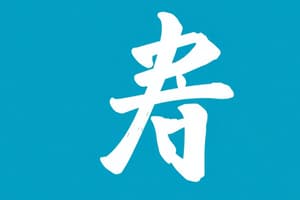Podcast
Questions and Answers
What is unique about the grammatical structure of Mandarin?
What is unique about the grammatical structure of Mandarin?
- It has a system of both inflectional endings and grammatical gender
- It has a complex system of inflectional endings
- It is an isolating language with no inflectional endings (correct)
- It is a language with grammatical gender
What is the primary difference between the Mandarin spoken in Taiwan and the Mandarin spoken in Singapore?
What is the primary difference between the Mandarin spoken in Taiwan and the Mandarin spoken in Singapore?
- Tone system
- Writing system
- Vocabulary and pronunciation (correct)
- Grammar
What is the name of the romanization system used to transcribe Mandarin into the Latin alphabet?
What is the name of the romanization system used to transcribe Mandarin into the Latin alphabet?
- Putonghua Transcription
- Hanyu Pinyin (correct)
- Chinese Latinization
- Mandarin Romanization
What is the approximate number of people who speak Mandarin worldwide?
What is the approximate number of people who speak Mandarin worldwide?
What is the name of the dialect of Mandarin that is considered the standard dialect?
What is the name of the dialect of Mandarin that is considered the standard dialect?
What type of writing system is used in Mandarin?
What type of writing system is used in Mandarin?
哪一个是桌子的中文名称?
哪一个是桌子的中文名称?
电视的中文名称是什么?
电视的中文名称是什么?
植物的中文名称是什么?
植物的中文名称是什么?
钢笔的中文名称是什么?
钢笔的中文名称是什么?
床头柜的中文名称是什么?
床头柜的中文名称是什么?
Flashcards are hidden until you start studying
Study Notes
Mandarin
Definition
- Mandarin is a dialect of Chinese, also known as Standard Chinese or Putonghua
- Official language of China and one of the six official languages of the United Nations
Characteristics
- Tonal language: distinguishes between four tones and a neutral tone
- Logographic writing system: uses characters (/) to represent words and concepts
- Grammatically, Mandarin is an isolating language: no inflectional endings, no grammatical gender
History
- Developed from the dialects of the Beijing region
- Became the official language of China in the 20th century
- Influenced by other languages, including English, Japanese, and Russian
Dialects
- Beijing dialect: considered the standard dialect
- Taiwan Mandarin: spoken in Taiwan, with some differences in vocabulary and pronunciation
- Singaporean Mandarin: spoken in Singapore, with influences from other languages
Spoken Mandarin
- Spoken by over 1 billion people worldwide
- Widely used in international communication, education, and business
Written Mandarin
- Uses simplified Chinese characters (/) in mainland China
- Uses traditional Chinese characters (/) in Taiwan, Hong Kong, and Macau
- Romanization systems, such as Hanyu Pinyin, are used to transcribe Mandarin into the Latin alphabet
Mandarin Definition
- Mandarin is a dialect of Chinese, also known as Standard Chinese or Putonghua.
- It is an official language of China and one of the six official languages of the United Nations.
Characteristics
- Mandarin is a tonal language, distinguishing between four tones and a neutral tone.
- It uses a logographic writing system, with characters (/) representing words and concepts.
- Mandarin is an isolating language grammatically, with no inflectional endings and no grammatical gender.
History
- Mandarin developed from the dialects of the Beijing region.
- It became the official language of China in the 20th century.
- Mandarin has been influenced by other languages, including English, Japanese, and Russian.
Dialects
- The Beijing dialect is considered the standard dialect.
- Taiwan Mandarin is spoken in Taiwan, with some differences in vocabulary and pronunciation.
- Singaporean Mandarin is spoken in Singapore, with influences from other languages.
Spoken Mandarin
- Over 1 billion people worldwide speak Mandarin.
- Mandarin is widely used in international communication, education, and business.
Written Mandarin
- Simplified Chinese characters (/) are used in mainland China.
- Traditional Chinese characters (/) are used in Taiwan, Hong Kong, and Macau.
- Romanization systems, such as Hanyu Pinyin, transcribe Mandarin into the Latin alphabet.
Furniture
- Bed is referred to as 床 (chuáng) in Chinese.
- 椅子 (yuèzi) means chair in Chinese.
- 桌子 (zhuōzi) is the Chinese term for table.
- 书桌 (shūzhuō) refers to a desk in Chinese.
- A bedside table is called 床头柜 (chuángtóu guì) in Chinese.
Electronics
- TV is referred to as 电视 (diànshì) in Chinese.
- The Chinese term for computer is 电脑 (diànnǎo).
- Sound systems or speakers are called 音响 (yīnxiǎng) in Chinese.
- 电话 (diànhuì) means phone in Chinese.
- Lamp is referred to as 灯 (dēng) in Chinese.
Decorations
- Picture is referred to as 照片 (zhàopiàn) in Chinese.
- Flower is called 花 (huā) in Chinese.
- 植物 (zhíwù) is the Chinese term for plant.
- Wallpaper is referred to as 壁纸 (bìzhǐ) in Chinese.
- Curtains are called 窗帘 (chuānglián) in Chinese.
Personal Items
- Bookbag is referred to as 书包 (shūbāo) in Chinese.
- Pen is called 钢笔 (gāngbǐ) in Chinese.
- Notebook is referred to as 笔记本 (bǐjìběn) in Chinese.
- Clock is called 钟 (zhōng) in Chinese.
- Jewelry is referred to as 首饰 (shǒushì) in Chinese.
Studying That Suits You
Use AI to generate personalized quizzes and flashcards to suit your learning preferences.




